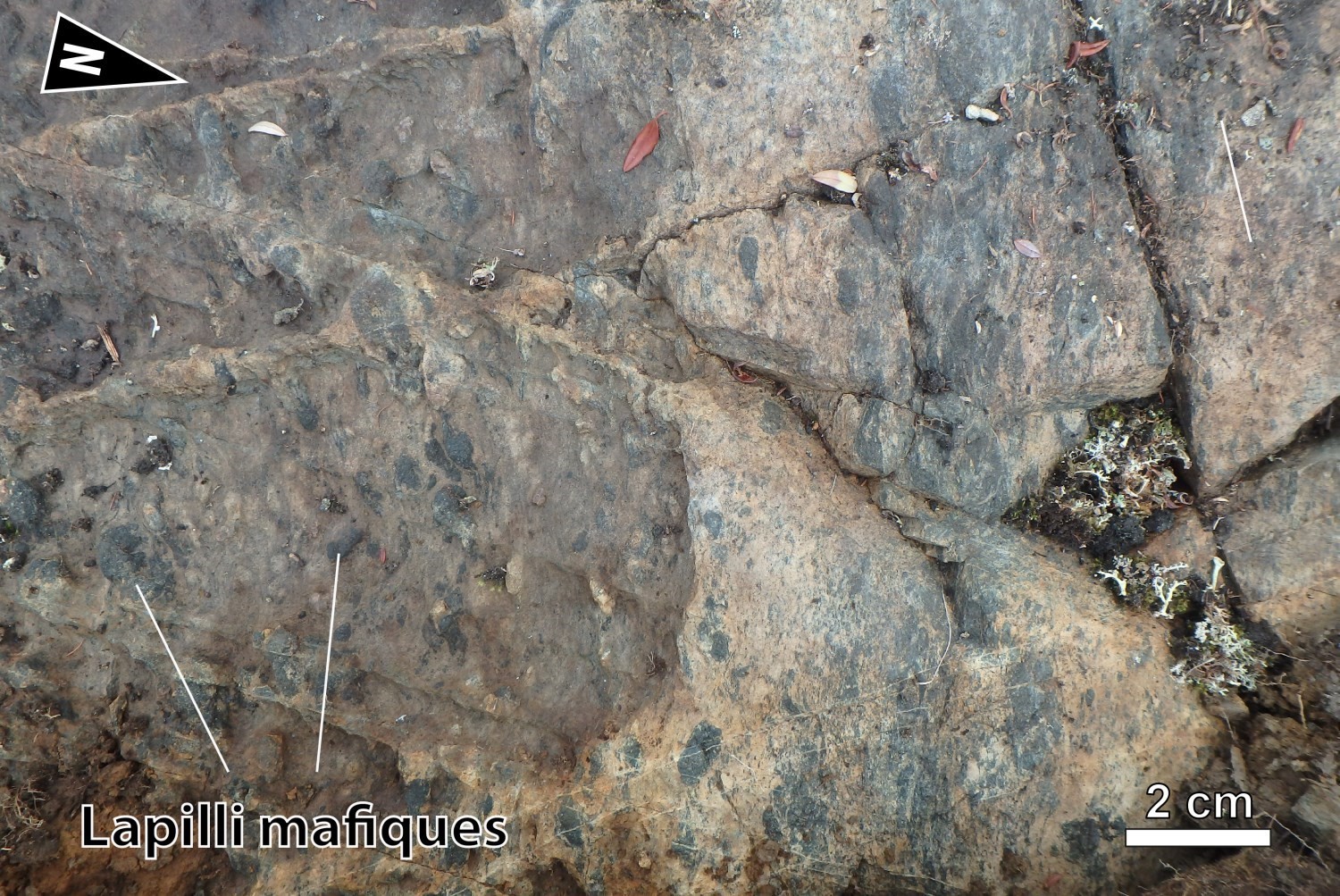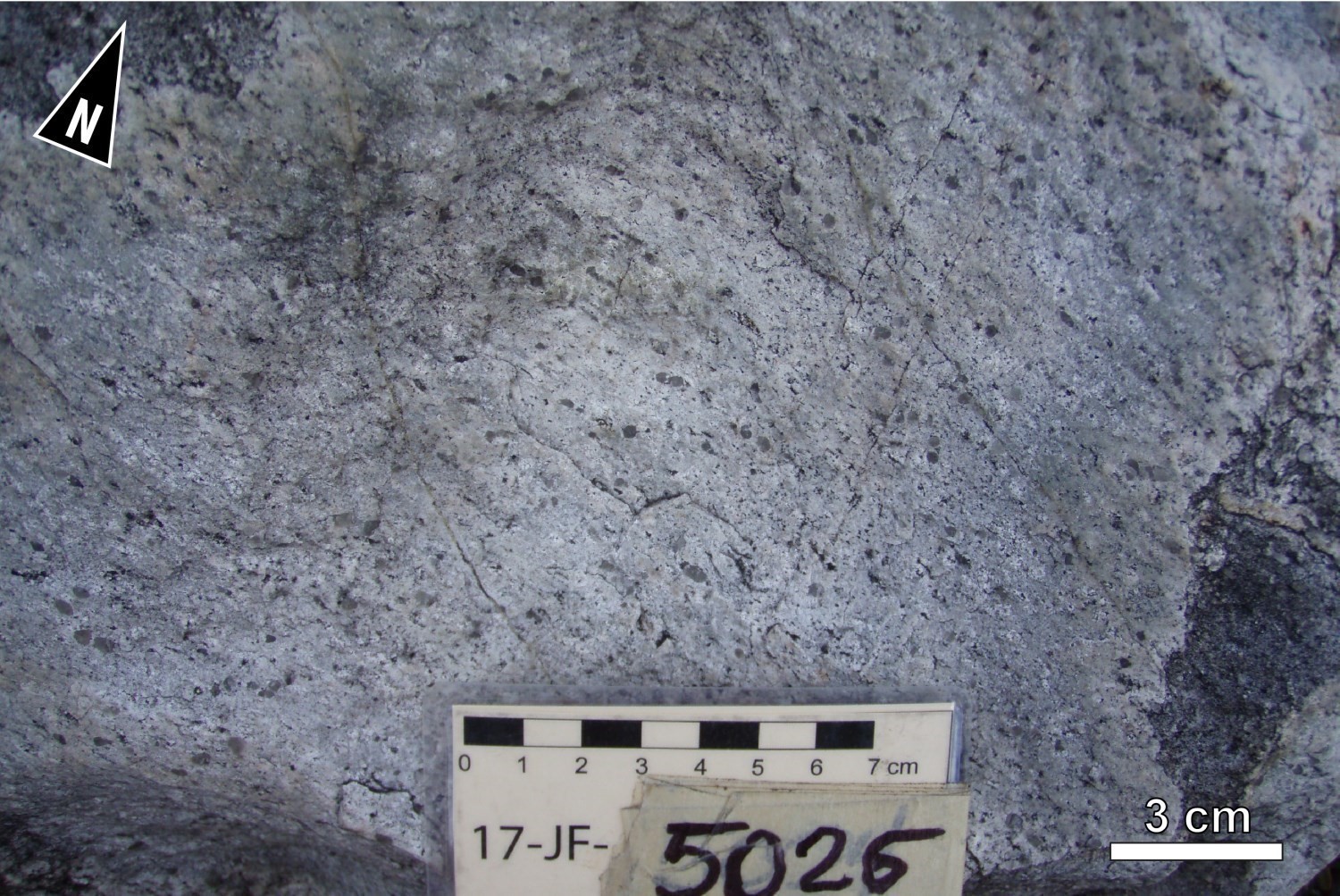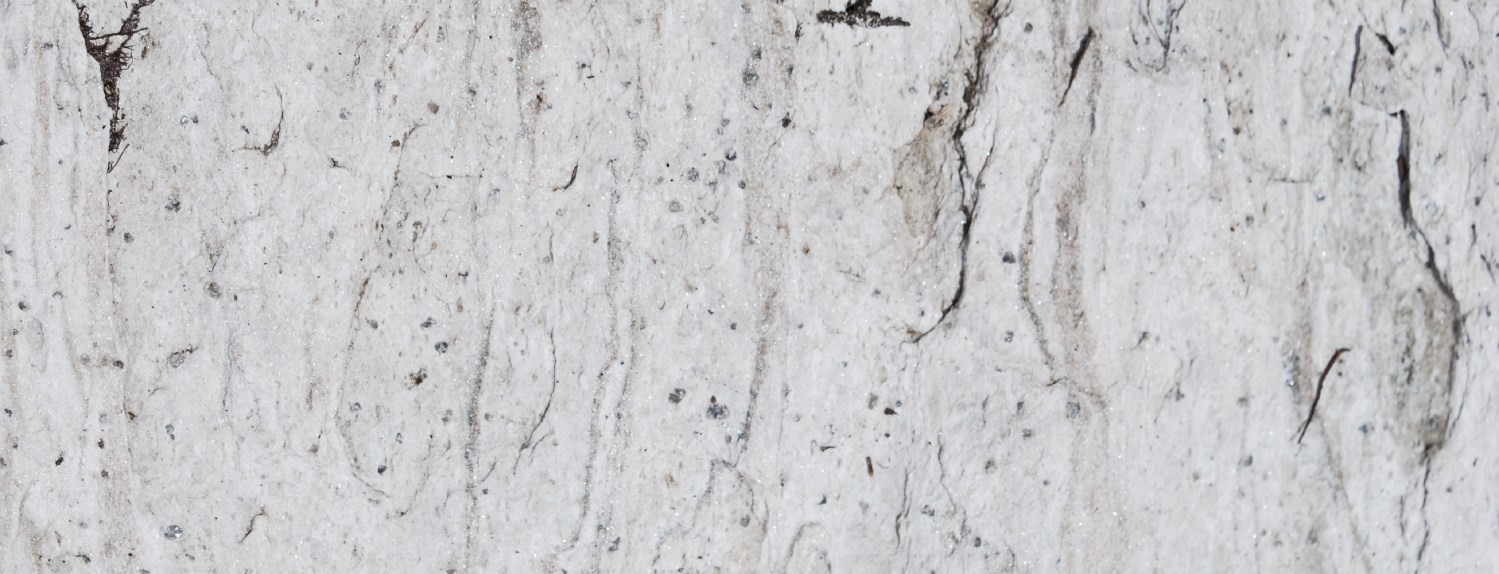
| Author: | Beauchamp et al., 2018 |
| Age: | Neoarchean |
| Stratotype: | None |
| Type area: | Bohier Island and Léran Lake areas (NTS sheets 33A08, 23D05, 23D11 and 23D12) |
| Geological province: | Superior Province |
| Geological subdivision: | Opatica Subprovince |
| Lithology: | Felsic to intermediate volcaniclastic and volcanic rocks, minor amounts of gabbro and basalt |
| Type: | Lithostratigraphic |
| Rank: | Formation |
| Status: | Formal |
| Use: | Active |
- René Group
-
- Érasme Formation
- Roman Formation
- Clément Formation
- Dolent Formation
Background
Volcaniclastic rocks and felsic volcanics of the Upper Eastmain Greenstone Belt (UEGB) were described in the works of Hocq (1985), Roy (1985, 1988), Couture (1986, 1987a, 1987b, 1987c, 1993) and Couture and Guha (1990). At that time, these authors included all of these rocks within the René Group, since no formation was individualized. Following mapping and geochronology in the Bohier Island and Cadieux Lake areas, Beauchamp et al. (2018) and Beauchamp (2019) divided the René Group into four formations. The Roman Formation was introduced to define the Neoarchean age rocks of the second volcanic event.
Description
In the southern branch of the Upper Eastmain Greenstone Belt, the Roman Formation consists mainly of volcaniclastics and felsic to intermediate volcanics, with minor amounts of gabbro and basalt. In the eastern branch of the UEGB, a greater lithological variety is present in the Roman Formation. It includes basalt, volcaniclastics and felsic volcanics, iron formations and garnet amphibolites, various sedimentary rocks (chert, mudstone, paraschist) and ultramafic rocks.
Geochemistry allowed the Roman Formation to be divided into eight informal units. Subunit nArmn1a, located only in the southern branch of the UEGB, includes felsic, ash, lapilli and block tuffs and rhyolitic to rhyodacitic lava. Subunit nArmn1b, located in the eastern branch of the UEGB, consists of an assemblage of felsic ash, lapilli and block tuff and rhyodactic to dactic volcanic. Intermediate tuffs were assigned to unit nArmn2, gabbros to unitnArmn3, and finally amphibolitized basalt to unit nArmn4t. Magnetic lineaments associated with iron formations and garnet amphibolites (nArmn5), thin horizons of mudstone and graphitic chert (nArmn6), sedimentary bands (nArmn7) and ultramafic sills (nArmn8) all are minor units within the Roman Formation.
Tuffs and felsic lava associated with subunits nArmn1a and nArmn1b are difficult to distinguish in the field. Subunits nArmn1a and nArmn1b form clouds of distinct points on the geochemistry diagrams of major and trace elements. They were formed at the same time, however, the source and depth of magmatic chamber setting would be different for these two felsic subunits. The rock source of subunit nArmn1b appears deeper (>30 km) than that of subunit nArmn1a. Rocks of subunit nArmn1b originate from a mafic source that has undergone a low degree of partial fusion at high pressures and with minimal fractionation (Lesher 1986 and Hart et al. 2004). The rock source of the nArmn1a subunit appears to be at intermediate depth (10-15 km) (Lesher 1986 and Hart et al. 2004). This source may have generated enough heat to initiate hydrothermal circulation on the ocean floor. The Bohier Island Pluton, which has a similar chemistry and age to the nArmn1a subunit, is considered the source of the Roman Formation felsic rocks.
Roman Formation 1 (nArmn1): Felsic Volcaniclastic Rocks
Roman Formation 1a (nArmn1a): Felsic Ash, Lapilli and Block Tuff, Rhyolite and Rhyodacite, Minor Amounts of Basalt and Intermediate Tuff
Several felsic rock faces have been recognized within the nArmn1a subunit, including ash tuff, lapilli tuff, lapilli and block tuff, crystal tuff, rhyolitic to rhyodacitic flows and dykes. These unit subdivisions are grouped into the same unit as they are impossible to isolate on the geological map.
Stratigraphic piling from the base to the top of the nArmn1a subunit is defined by a section through the outcrops of 17-SB-4025, 17-SB-4024, 17-SB-4023 and 17-JM-6005. The pile begins with a sequence of ash and lapilli tuffs that overlain by crystal tuffs and massive porphyritic flows. At the top of the pile, outcrop 17-JM-6005 exhibits an autoclastic rhyolitic breccia facies.
Ash or Lapilli or Block Tuff
The tuff has a varied composition in both the nature of the matrix and the fragments. The ash tuff is distinguished by its well-preserved bedding. The lapilli tuff is very heterogeneous. The lapillis, in positive relief, can be mafic or felsic. They represent between 5 and 20% of the rock and are of varying sizes (2 to 64 mm). A few lapilli and block tuffs (>64 mm) are present. Some outcrops show alternating fragmentary passages with ash-filled passages. The felsic volcaniclastics matrix contains quartz, plagioclase, biotite, epidote (zoisite, pistachite), with varying amounts of amphibole, carbonate, tourmaline, zircon, sphene, rutile and opaque minerals. Mafic lapillis are composed of amphibole, plagioclase, epidote (clinozoisite, pistachite) and chloritized biotite. Felsic lapillis are less common and are made up of quartz, plagioclase and mica. They are difficult to identify since their mineralogical composition is often similar to the felsic volcanoclastics matrix.
Quartz Crystal Tuff
The quartz crystal tuff has a light beige altered patina, and a light grey fresh surface. It is easily recognizable in the field by the presence of 10 to 20% rounded to subrounded quartz crystals that measure 0.1 to 0.5 cm. This tuff has a fine-grained matrix composed of quartz and plagioclase with minor amounts of sericite, biotite and epidote. Some garnet porphyroblasts are very restricted. Tuff horizons are generally non-magnetic and low to medium foliated, in addition to being locally bedded. Some crystal tuffs also contain small altered white-beige lapillis 1 to 3 mm in length that are slightly rounded and stretched according to the main foliation. Automorph and damouritized plagioclase phencrystals are present in a few thin sections. Biotite is chloritized and aligns to the main shistosity. Muscovite in a large prism cuts the minerals aligned in the main foliation. Variable amounts of microcline, carbonate, tourmaline, zircon, sphene, rutile, apatite and opaque minerals were observed in petrography. The crystal tuff is frequently altered in sericite and epidote.
Rhyolitic and Rhyodacitic Flow
Some volcanic structures suggest the presence of felsic domes. Banding and laminations that resemble “flow Blanding” type laminar flow structures were described. Some felsic lava are present in the form of massive porphyritic, rhyolitic and rhyodacitic flows (Hocq 1985; Beauchamp and Massei 2018). Quartz and plagioclase appear as phenocrystals that make up 20-40% of the rock. Quartz grains are subspheric and are between 0.2 and 0.8 mm in diameter. Plagioclase, low to moderately damouritized, is hypidiomorphic and measures between 2 and 10 mm. Flakes of coarse-grained muscovite and chloritized biotite are present. Epidote, apatite, zircon, carbonates and opaque minerals are the main accessory minerals. This rock is massive and shows no banding or lamination as is the case with crystal tuffs. Outcrop 17-JM-6005 is typical of a felsic volcanic. It exhibits autoclastic brecciation structures typical of the outer edges of felsic domes. This facies is rich in granoblastic quartz and contains 10% plagioclase, 25% sericite defining foliation, 10% biotite and calcite, tourmaline and garnet as accessory minerals.
Schist with felsic volcanics and tuffs as protolith
Some of subunit nArmn1a rocks have undergone significant aluminous alteration (alkaline leaching) superimposed on metamorphism at the upper amphibolites facies. These rocks, which are located near René Lake, have lost most of their primary structure, making their identification problematic. Laminations and fragmentary passages have been completely obliterated. These rocks are more schist-like. Their matrix is rich in quartz-sericite and contains up to 20% sillimanite porphyroblasts, 15% poeciloblastic garnet traces and 15% pinitized cordierite traces. Fibrolite replaces ancient nodules, possibly of andalousite. Quartz-rich depletion halos are present around the garnet. The main schistosity of these rocks is marked by the alignment of phyllosilicates (chloritized biotite, white mica).
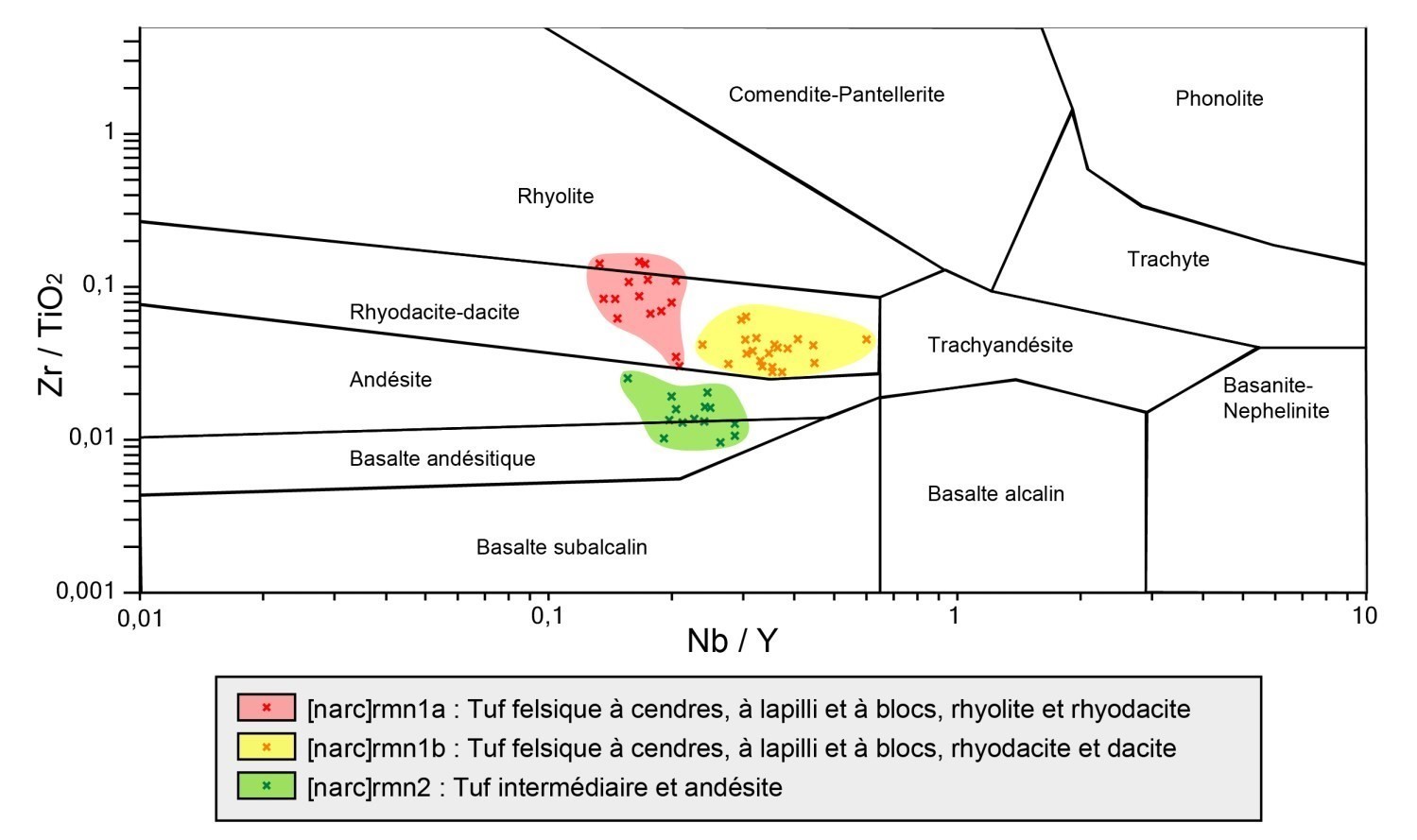
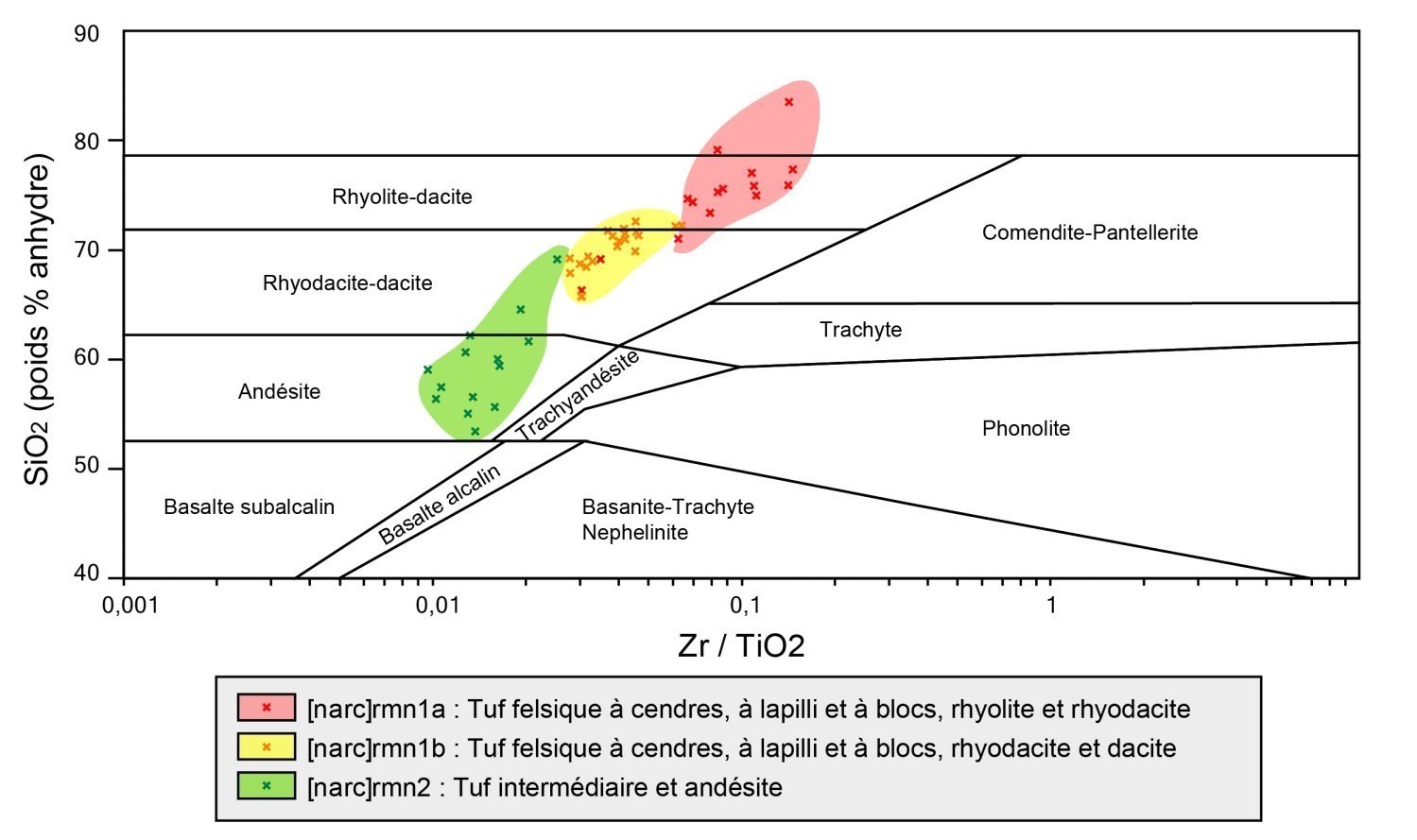
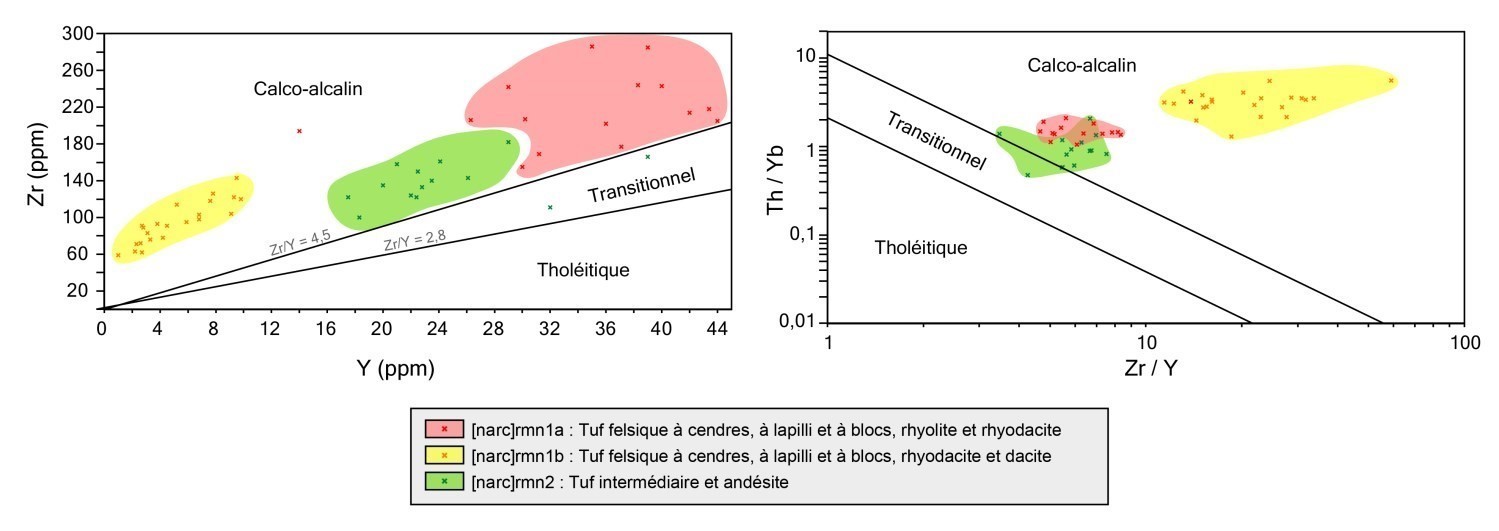
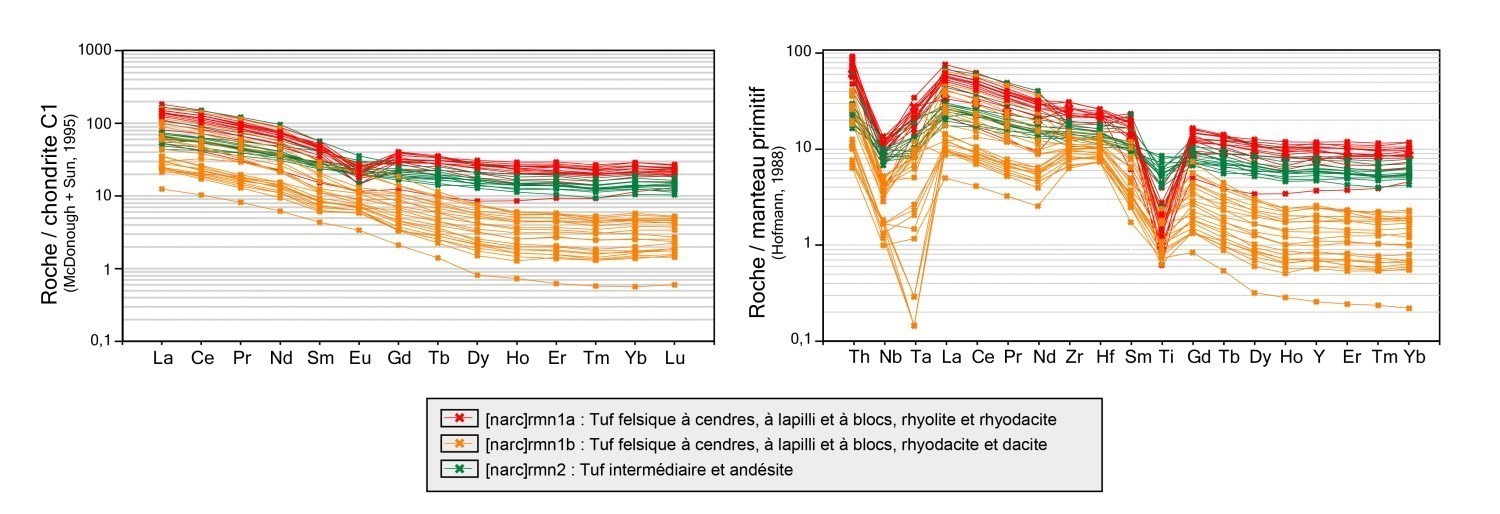
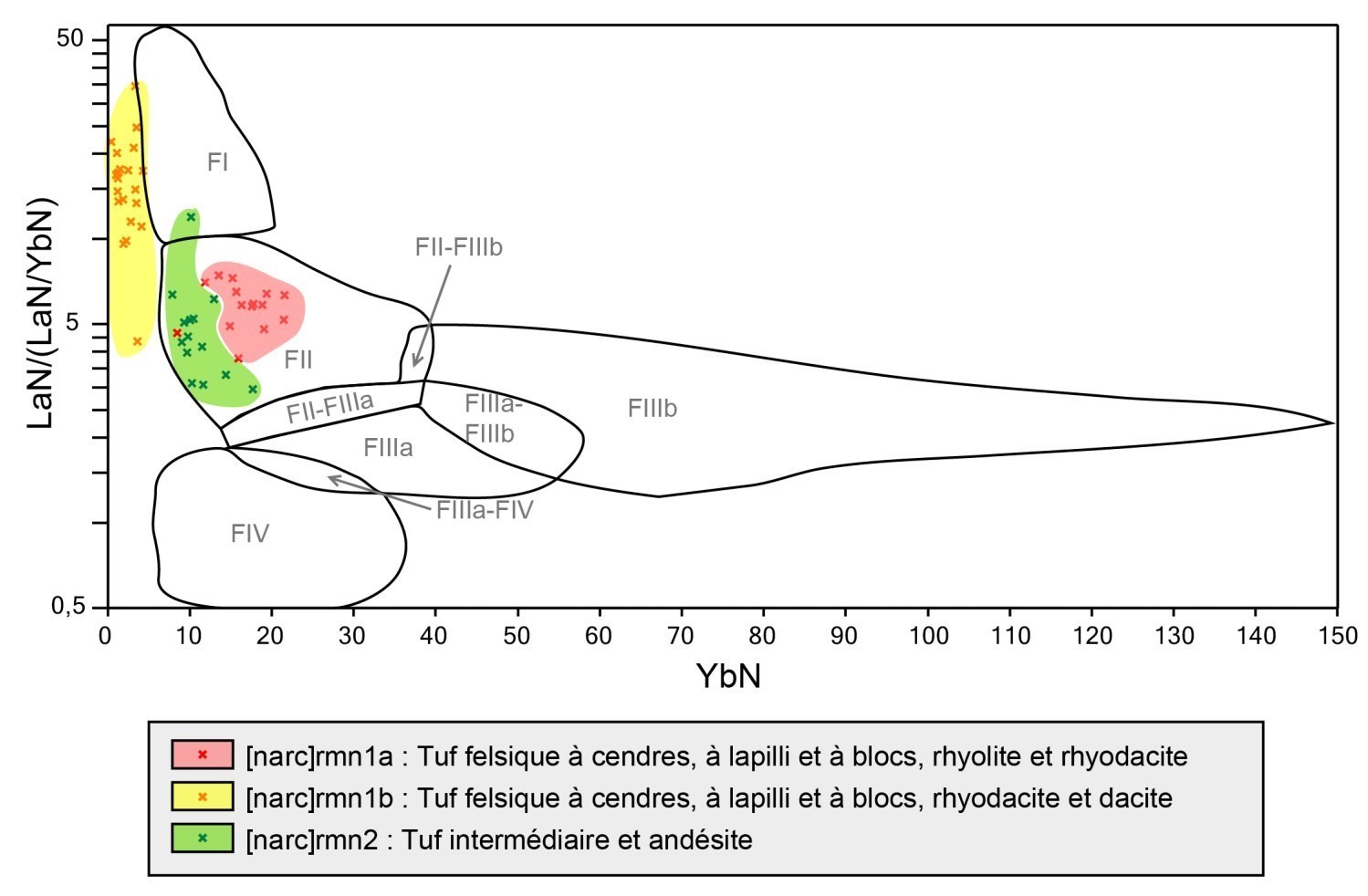 Felsic rocks of subunit nArmn1a have a rhyolitic to rhyodacitic composition and a calc-alkaline affinity. They have 65-83 % SiO2, 0.1-0.6 % TiO2, 14-44 ppm Y, 155-286 ppm Zr, 1.8-4.6 ppm Yb and Zr/Y ratios of 4.6-13.9. They are characterized by fractionated rare earth diagrams showing light rare earth enrichment relative to heavy rare earths (mean [La/Yb]CN = 6; mean [Gd/Yb]CN = 1.5). Rocks have a small negative Eu anomaly (Eu/Eu* = 0.4 to 0.8). Negative anomalies in Nb, Ta and Ti are present on spider diagrams. In the fertility diagrams of felsic volcanics (Lesher 1986a; Lesher 1986b; Hart 2004; Pearson 2007), rocks of the nArmn1a subunit are located in the field of FII-type rhyolites.
Felsic rocks of subunit nArmn1a have a rhyolitic to rhyodacitic composition and a calc-alkaline affinity. They have 65-83 % SiO2, 0.1-0.6 % TiO2, 14-44 ppm Y, 155-286 ppm Zr, 1.8-4.6 ppm Yb and Zr/Y ratios of 4.6-13.9. They are characterized by fractionated rare earth diagrams showing light rare earth enrichment relative to heavy rare earths (mean [La/Yb]CN = 6; mean [Gd/Yb]CN = 1.5). Rocks have a small negative Eu anomaly (Eu/Eu* = 0.4 to 0.8). Negative anomalies in Nb, Ta and Ti are present on spider diagrams. In the fertility diagrams of felsic volcanics (Lesher 1986a; Lesher 1986b; Hart 2004; Pearson 2007), rocks of the nArmn1a subunit are located in the field of FII-type rhyolites.
Roman Formation 1b (nArmn1b): Felsic Ash, Lapilli and Block Tuff, Rhyodacite and Dacite
Subunit nArmn1b rocks are white in altered surface and light grey to beige in fresh exposure. This unit includes felsic tuffs and felsic dykes and flows. Rocks of the nArmn1b subunit form thin horizons interbedded in mafic volcanics of the René Group. Three bands in the eastern part of the UEGB are thicker (0.5 to 1 km) and better defined. Felsic volcanics are hololeucocrates and have a conchoidal fracture typical of felsic rocks. They are fine grained. They’re rarely magnetic. Paragenesis of felsic tuffs and volcanics consists of 50-60 % single crystal quartz, 5-35 % plagioclase, white mica (sericite and muscovite), chlorite, minor amounts of biotite, epidote, calcite, amphibole (hornblende and actinolite) and traces of zircon, rutile, apatite and opaque minerals. It is a foliated and locally crenulated unit with a lepidoblastic structure. Foliation is marked by the alignment of phyllosilicates. The felsic volcanics matrix is granoblastic and essentially quartz. Plagioclases are moderately to heavily altered in sericite. Rock is also affected by varying levels of epidote, calcite and chlorite alteration. Much of the primary volcanic structures are obliterated by strong foliation and regional metamorphism, but quartz eyes (0.5 to 4 mm long), hypidiomorphic plagioclase phencrystals (0.5 to 6 mm long), lapilli and blocks are visible in a few places (outcrop 2016-SB-4145). Remains of devitrification structures marked by spherulites replaced by muscovite and chlorite are locally observable. felsic volcanics, which show microporphyritic facies, are characterized by the presence of 5-15 % plagioclase microcrystals, can contain locally up to 20% subrounded quartz phenocrystals and are stretched. Felsic tuffs and volcanics are all cut by 2-5 % calcite quartz veins.
Subunit nArmn1b has a rhyodactic and dactic composition and calc-alkaline affinity. It is characterized by 64-72% SiO2, 0.1-0.4% TiO2, 1-10 ppm Y, 59-143 ppm Zr, 0.1-0.9% Yb and Zr/Y ratio 11.4-59 ppm. Rocks of the Armn1b subunit are characterized by fractionated rare earth diagrams showing light rare earth enrichment relative to heavy rare earths (mean [La/Yb]CN = 17; mean [Gd/Yb]CN = 2.5). Only a few profiles have a very small positive or negative Eu anomaly (Eu/Eu* = 0.8 to 1.2). Rocks of the nArmn1b subunit have more rare earth-depleted diagrams than those of the nArmn1a subunit. This difference is all the more pronounced for heavy rare earths. Tuffs and felsic lava of the nArmn1a subnit contain more garnet than rocks of the nArmn1b subunit. In fertility diagrams of felsic volcanics (Lesher 1986a; Lesher 1986b; Hart 2004 and Pearson 2007), rocks of the nArmn1b subunit are again distinguished from rocks of the nArmn1a subunit, and they fall into the FI-type rhyolites field.
Roman Formation 2 (nArmn2): Intermediate Tuff and Andesite
Intermediate tuff and andesite outcrops are very heterogeneous from a compositional perspective. Three main facies that cannot be individualized on the map have been described. In the Bohier Island area, intermediate tuffs are affected by at least two shistosity phases.
Amphibole and Biotite Cluster Intermediate Tuff
The amphibole and biotite cluster intermediate tuff consists of a pale beige-grey rock in altered surface and medium grey in fresh exposure. This is the most abundant facies of unit nArmn2. It is distinguished by the presence of amphibole and biotite clusters oriented to the main lineation. These clusters are millimetre in size and reach 1 cm. When present, bedding is marked by a change in size. The tuff matrix is composed of amphibole, saussuritized plagioclase, quartz with varying amounts of biotite, chlorite and epidote. Traces of zircons, sphene, rutile and opaque minerals are present. Two types of amphiboles (actinolite and hornblende) and traces to 3% garnet porprhyroblasts are present. Hornblende is coarse grained and poeciloblastic. Actinolite forms elongated rods. Plagioclase phencrystals make up between 0 and 10% of the rock. A few lapillis and blocks of garnet amphibolite can be seen in the tuff. It is generally non-magnetic and frequently altered in chlorite, epidote, hematite and silica.
Porphyritic Andesite
Porphyritic andesite is an intermediate rock that contains 3-15 % plagioclase phenocrystals. It has a pale green, sometimes greyish, altered surface and a medium grey fresh exposure. It is non-magnetic and is composed mostly of amphibole (30-60 % actinolite or hornblende) with sericitized quartz and plagioclase and varying amounts of biotite, epidote, garnet and chlorite. Feldspath, quartz and carbonate veins cut the unit.
Intermediate Lapilli Tuff
Intermediate lapilli tuff outcrops were observed. The matrix of these tuffs is composed of amphibole, plagioclase, quartz with varying amounts of chloritized biotite, chlorite, epidote, muscovite and garnet. The fragments are of felsic or mafic composition and represent between 5 and 40% of the rock.
Unit nArmn2 has a predominantly intermediate composition (andesitic and dacitic) and calc-alkaline affinity. It is characterized by 53-68 % SiO2, 0.4-1.4 % TiO2, 17-39 ppm Y, 100-182 ppm Zr, 1.7-3.8 ppm Yb and a Zr/Y ratio of 11.4-59. Unit nArmn2 rocks have fractionated rare earth profiles, characterized by light rare earth enrichment relative to heavy rare earths (mean [La/Yb]CN = 5; mean [Gd/Yb]CN = 1.5). In addition, only a few diagrams have very low negative Eu anomaly (Eu/Eu* = 0.5 to 1).
Roman Formation 3 (nArmn3): Gabbro
Gabbroic intrusions are difficult to differentiate from basalt outcrops (nArmn4). Gabbroic sills are cogenetic and have geochemistry similar to mafic effusive rocks. The gabbros are dark green in altered patina and slightly lighter in fresh exposure. They are medium grained and weakly foliated. They are mesocratic to melanocratic and have a subophitic to ophitic structure. They contain 60-85 % amphiboles (hornblende or actinolite), 10-30 % plagioclase with less quartz, epidote, clinozoisite, calcite, rutile, sphene and opaque minerals. Plagioclase is weakly to moderately altered in sericite or epidote. Some samples contain amphibolitized pyroxene pseudomorphs (20 to 50 mm).
Roman Formation 4 (nArmn4): Amphibolitized Basalt
Mafic lava are blackish in altered surface and forest green in fresh exposure. These rocks have a wide variety of facies. The two main facies that have been documented are the pillow facies and the massive flows. Massive flow basalt is highly amphibolitized. Because of metamorphic overprinting, the more coarse-grained basalt can easily be confused with a gabbroic sill contemporary with the construction of the volcanic band (Hocq 1985; Roy 1988; Talla Takam et al., in preparation). In the Léran Lake area, an outcrop of coarse-grained (hornblende 0.5 cm) pillow basalt was observed. Pillows are well individualized and range from 0.2 to 1 m. Edges are millimetric to centimetric. Pillows are often flattened in the direction of regional foliation. Unlike basalts of the Érasme and Clément Formations, it is difficult to define precisely stratigraphic polarity in the basalts of the Roman Formation since the peduncles and quartz chambers are deformed and rarely preserved. In some places, mega-pillows are found up to 2 m in diameter and decametric micro-pillows. Porphyritic basalts with plagioclase phencrystals were observed in the Tiers-État Lake area (Roy 1988). Plagioclase phenocrystals, which account for 10 to 15% of the rock, are 2 to 3 cm in diameter (Roy 1988), and are altered in sericite and epidote. The paragenesis of amphibolitized basalt is relatively constant. They contain 50-70 % green hornblende (locally actinolite), damouritized plagioclase, epidote, sericite and lower amounts of chlorite, calcite, quartz, biotite, garnet, sphene, zircon and opaque minerals. The most magnetic basalts contain more actinolite than hornblende. Basalts are rarely magnetic and of variable grain size, ranging from very fine to medium. They have subophitic to ophitic structures. Biotite is locally present and partially chloritized. Altered basalts contain more biotite and calcite. Some basaltic facies contain elongated quartz plagioclase amygdules. Some pyroxene phenocrystals (10 to 20 mm) are present in the massive flow facies and appear to be pseudomorphs of amphibolitized pyroxene grains.
Unit nArmn4 consists of subalkaline basalt, amphibolitized andesitic basalt, magnetic basalt and amphibolite. Mafic volcanics are subalkaline and of predominantly tholeitc to locally transitional affinity. Mafic rocks are characterized by relatively flat rare earth profiles, with contents 5 and 40 times higher than chondrite. They show moderate depletion of light rare earths ([La/sm]CN = 0.6 to 1.9; [La/Yb]CN = 0.6 to 2.6) and very small positive or negative anomalies in europium ([Eu/Eu*] = 0.7 to 1.2). These rocks are low-depleted in Th and U, highly depleted in Nb, Ta and Ti, and have small plateaus in Zr-Hf. As defined by tectonic environmental diagrams, mafic rocks of the eastern branch of the UEGB are oceanic ridge basalts that have undergone shallow melting. These are N-MORB-type rocks that appear to have been affected by crustal contamination (Pearce 2008).
Roman Formation 5 (nArmn5): Iron Formation and Garnet Amphibolite
Iron formations represent only a very small proportion within the Roman Formation. They are in thin, folded bands, discontinuous and boudinaged. Their extension is interpreted from the continuities on aeromagnetic charts. Iron formation outcrops are banded. These include partially silicified and partially oxidized mixed iron formations or silicate facies iron formations. They are usually composed of alternating millimetric to centimetric bands of greyish chert and greenish yellow to orange-brown bands containing amphiboles (grunerite, hornblende), garnet porphyroblasts and a few magnetite veinlets. The quartzite recrystallized chert bands are weakly boudinaged. Iron formations contain 2-10 % sulphide (pyrite and pyrrhotite).
Amphibolites with garnet porphyroblasts of tholeitic affinity highly enriched in iron (MgO between 4 and 5 wt. % and Fe2O3T between 21 and 29%) are associated with iron formation bands. Amphibolites are dark greenish in altered surface and medium green in fresh exposure. They are medium grained and have nematoblastic structures. Their paragenesis consists mostly of green amphibole, moderately to highly sericitized plagioclase, ilmenite and smaller amounts of biotite, garnet, epidote and quartz. Amphibolites contain 10-30 % garnet porphyroblasts. Garnet is hypotomorphic to idiomorphic, poecilitic and is 2 to 10 mm in diameter. Edges of the grains are irregular and their growth is overprinted on the main foliation. Garnet is late-tectonic to post-tectonic.
Roman Formation 6 (nArmn6): Mudstone and Graphitic Chert
Some mudstone and graphitic chert outcrops were mapped in the northern portion of the UEGB north branch, specifically north and east of Harbour Lake (Talla Takam et al., in preparation). These outcrops are a minority within the Roman Formation. The thickness of this unit varies from 5 cm to a maximum of 5 m. The mudstones and graphitic cherts have a rusted blackish altered patina and are greyish to blackish in fresh exposure. These horizons are very fine grained. They are finaly laminated (stratified) and affected by the main deformation. Tight folds are common. They are made up of quartz, graphite, magnetite and 2-10 % sulphides, mainly pyrrhotite and pyrite with minor quantities of chalcopyrite.
Roman Formation 7 (nArmn7): Paraschist, Paragneiss and Wacke
In the upper part of the eastern branch of the Upper Eastmain Greenstone Belt, horizons of paraschist and wacke paragneiss sedimentary rock were emplaced between volcanic flows. These horizons were not observed in the latest mapping campaign conducted by the Ministère (Beauchamp et al., 2018). However, they were intercepted by diamond and reverse-flow drilling and described in exploration reports.
The majority of the paraschist is composed of quartz and plagioclase, which account for more than 80% of the rock, as well as biotite, garnet and hornblende (Chapdelaine 1995). A millimetric to centimetric banding consisting of alternating bands of light grey (70% of the rock), red brown (20% of the rock) and dark green (10% of the rock) is visible. The rock is fine grained and not magnetic. At drilling level 40349-95-06, the protolith is more difficult to identify. The rock is more schistose, more epidotized, and plagioclase has been replaced by sericite. The rock also contains up to 10% siliceous and stretched centimetric fragments.
Wacke paragneiss horizons were also described. They are grey, brown grey, green-grey and black grey, fine to medium grained, and rarely magnetic. Rarely sheared, the rock shows millimetric to centimetric bands that are distinguished by variations in grey shades. The main minerals are quartz, plagioclase, biotite, garnet and chlorite (Chapdelaine 1995). Hornblend is also present (Beland 2015). Ferromagnesian minerals generally account for 2-5% of the rock, but some horizons can be much richer (up to 50%). Almandine garnet shows shades of pink to orange. Primary bedding was observed in drill core LHRC-15-047 (Beland 2015). Finally, the rock contains minor amounts of calcite.
Roman Formation 8 (nArmn8): Ultramafic Sill
Ultramafic sill horizons are interbedded in the volcanic sequence of the eastern branch of the UEGB. It is possible that the Roman Formation contains horizons of ultramafic volcanics, but no volcanic structures have been observed on outcrops. Chapdelaine (1995), however, reported locally observing a spinifex structure in the northern portion of the branch.
In the southern portion of the branch (sheet 23D05), a discontinuous band could be interpreted based on magnetic anomaly maps and outcrop 17-MC-3172. It is a peridotite with a cumulate structure, blackish in fresh exposure and orange in altered surface. The rock is very magnetic. It contains mainly olivine or pyroxene, whose intense retrograde metamorphism into serpentine makes accurate mineralogical identification difficult. Olivine and pyroxenes are found in a matrix consisting of carbonates, acicular crystals of tremolite, talc and magnetite. The relatively low Cao content (3.6%) relative to the amount of carbonate and the orange patina of the rock indicate that the carbonate present is ankerite or even siderite. The rare earth profile of the sample from outcrop 17-MC-3172 shows a very clear enrichment of light rare earths relative to heavy rare earths, with a La/Yb ratio of 235. The mineral carrier of light rare earths could not be identified in thin section.
In the northern portion of the branch, the nArmn8 unit consists of a few ultramafic rock klippes and a more continuous horizon observed at outcrop 16-MP-2177, TR 13-04 stripping site (Béland 2013) and likely intercepted by drilling 4034-97-8, 4034-97-9 and 4034-97-10 (Tyson 1997) and 4034-95-03 (Chapdelaine 1995). The rock is green-grey to light-green, homogeneous, altered, massive to well foliated and fine to medium grained. It is generally non-magnetic, except when pyrrhotite is present. At drilling 4034-97-9, it is brecciated and contains fragments of basalt. Mostly made of tremolite, the rock also contains talc, actinolite and some biotite or phlogopite locally. Pyrite, pyrrhotite and chromite are also observed locally. The main alterations are chloritization, locally intense, and carbonation.
Thickness and Distribution
The Roman Formation outcrops in the south and east branches of the UEGB. Units nArmn1a and nArmn2 are located in the south branch of the belt. They form a continuous band whose true thickness varies between 250 m and 3.5 km. The eastern branch, which includes units nArmn1b and nArmn3 to nArmn8, is 75 km long and its true thickness varies between 3 and 4.5 km.
Dating
Two dates made it possible to constrain the age at which the Roman Formation was emplaced. A felsic lapilli tuff (nArmn1b) sampled in the eastern branch of the UEGB yielded an age of 2770 ±6 Ma. A felsic porphyritic volcanic rock of rhyodacitic composition at the top of the Roman Formation pile (nArmn1a) was dated 2770 ±3 Ma.
| Isotopic System | Mineral | Crystallization Age (Ma) | (+) | (-) | Reference(s) |
| U-Pb | Zircon | 2770 | 6 | 6 | Davis and Sutcliffe, 2018a |
| U-Pb | Zircon | 2770 | 3 | 3 | Davis and Sutcliffe, 2018b |
Stratigraphic Relationship(s)
The Roman Formation is part of the René Group. It corresponds to the second volcanic event of the Upper Eastmain Greenstone Belt. The Roman Formation is younger than the Érasme Formation (2800 ±6 Ma; Davis and Sutcliffe, 2018b) and older than the Clément Formation (<2770 Ma) and Dolent Formation (2751 ±5 Ma; Davis, personal communication, 2019). This unit is in discordant and faulted contact with Bohier Group sedimentary rocks. Contacts between various formations of the René Group were not observed.
The Île Bohier Pluton (2771 ±6 Ma; Davis and Sutcliffe, 2018b) is synvolcanic and contemporary to the emplacement of the Roman Formation. Tonalitic and granodioritic rocks of the Bohier Island Pluton are geochemically very similar to felsic rocks of the Roman Formation. This observation suggests that the Bohier Island Pluton is the source of felsic and intermediate volcaniclastics and volcanics of the Roman Formation.
The Chiyaaskw Pluton, the Wahemen Suite and the Gaël Intrusive Suite distinctly cut the Roman Formation.
Paleontology
Does not apply.


